MARIANI’S
February
17, 2008
NEWSLETTER
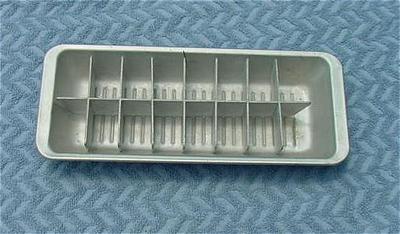
NEW! Click esquire.com
to go to my new column at Esquire Magazine.
ARCHIVE: Readers may now access
an
Archive of all past newsletters--each annotated--dating back to July,
2003, by simply clicking on www.johnmariani.com/archive
Restaurant
Index: A complete list of restaurants covered in this
newsletter
since 2003. Please
click here.
SUBSCRIBE AND
UN-SUBSCRIBE: You may subscribe anyone you wish
to this newsletter--free of charge--by
clicking here.
~~~~~~~~~~~~~~~~~~~~~~~~~~~~~~~~~~~~~~~~~
In
This Issue
NEW YORK CORNER: Grayz by John Mariani
NOTES FROM THE WINE CELLAR: Duckhorn Still Sets the Mark for American Merlot by John Mariani
QUICK BYTES
~~~~~~~~~~~~~~~~~~~~~~~~~~~~~~~~~~~~~
EATING HONG KONG, Part Three
by John A. Curtas
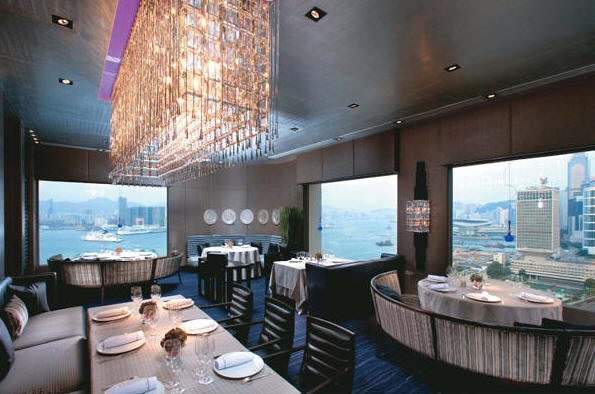 One
of the biggest
stars is Pierre Gagnaire, who, along with Alain Ducasse (Spoon) and
Joël
Robuchon (L’Atelier de Joël Robuchon), has established a French
presence
here. Having eaten nine years ago at
Gagnaire’s namesake restaurant in
One
of the biggest
stars is Pierre Gagnaire, who, along with Alain Ducasse (Spoon) and
Joël
Robuchon (L’Atelier de Joël Robuchon), has established a French
presence
here. Having eaten nine years ago at
Gagnaire’s namesake restaurant in I still remember a dish of sweetbreads impaled on a cinnamon stick, set beneath a teepee of smoldering cinnamon that was beyond delicious but so intricately constructed I knew not whether to eat it or start playing cowboys and Indians with the food. While not as outrageous as the wacky Spanish in his embrace of molecular gastronomy, Gagnaire has always been considered one of the more inventive and cutting edge French chefs, and how those avant-garde urges played to a Chinese audience was something I had to see.
 Like many of
the courses, the first offering
of roasted bread beef jelly with melted Beaufort cheese and chorizo,
with
Boudeuses oysters sitting in a
lightly smoked beetroot
purée, sounded
complicated, looked simple, and tasted divine. Next
came the simplest
dish of the eight courses: Imperial prawns with pink grapefruit, pears
and
pineapple cubes sitting in a crab-and-verbena-flavored aspic (left), followed by de-constructed
cuttlefish, in a tomato
ravioli with tuna and grilled baby squid, a perfect melding of
earth,
sea, sharp and mellow flavors.
Like many of
the courses, the first offering
of roasted bread beef jelly with melted Beaufort cheese and chorizo,
with
Boudeuses oysters sitting in a
lightly smoked beetroot
purée, sounded
complicated, looked simple, and tasted divine. Next
came the simplest
dish of the eight courses: Imperial prawns with pink grapefruit, pears
and
pineapple cubes sitting in a crab-and-verbena-flavored aspic (left), followed by de-constructed
cuttlefish, in a tomato
ravioli with tuna and grilled baby squid, a perfect melding of
earth,
sea, sharp and mellow flavors.What arrived next looked like a Caesar Salad topped with ice cream, which turned out to be an intermezzo of romaine greens, girolles, trompettes, and Medjoul dates tossed in coconut milk and topped with a savory tarragon and apple sorbet. It won my award for the best-tasting, most innocuous-looking dish I have ever eaten.
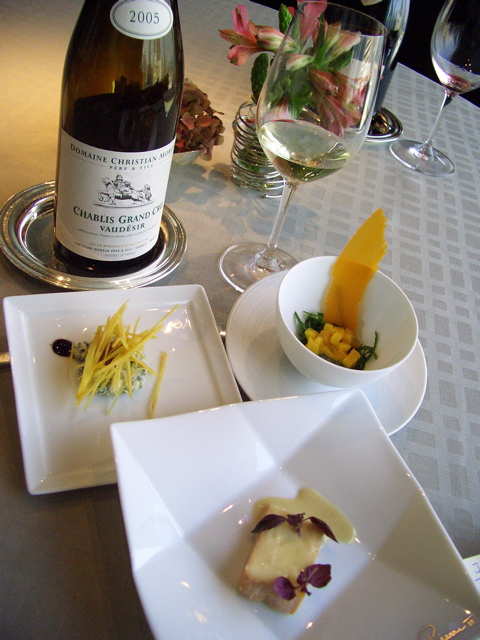 The next course resembled sea bass topped
with Captain Crunch, but the crispy things on top were puffed and
crunchy wheat
grains, so the breakfast cereal analogy wasn’t far off.
As the three-hour lunch hit the home stretch,
a confit-like roasted wild duck, wrapped around sauerkraut, green
cabbage
and caramelized salsify appeared in a port wine sauce so rich I thought
the
British must have never left the island.
The next course resembled sea bass topped
with Captain Crunch, but the crispy things on top were puffed and
crunchy wheat
grains, so the breakfast cereal analogy wasn’t far off.
As the three-hour lunch hit the home stretch,
a confit-like roasted wild duck, wrapped around sauerkraut, green
cabbage
and caramelized salsify appeared in a port wine sauce so rich I thought
the
British must have never left the island.The cheese course (right) was a wonder in its own right--Mimolette with chopped spinach and a diced mango and vegetable broth jelly, Muenster with almond cream, and Bleu d’Auvergne alongside sultanas and yellow carrot sticks. Dessert was a simple affair, if you call a wine poached orange slice wrapped around mascarpone cheese and showered with white truffles, simple. In all, the meal was inventive without being overwrought, and gutsier and a tad more conservative than I remember Gagnaire’s cuisine being from a decade ago. But I can’t imagine food being any better.
The prix fixe dégustation lunch at
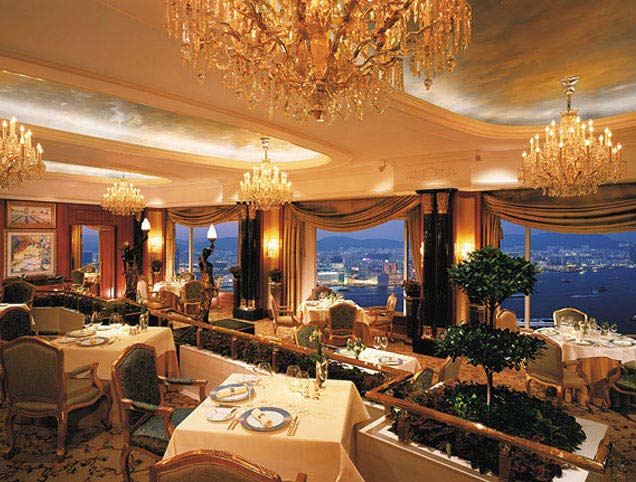 After
the pirouettes by
After
the pirouettes by The design, befitting the name and Chabbert's cuisine, puts
Starter courses at Pétrus are $30-45USD and main courses run $47-72USD.
The food at Aqua (
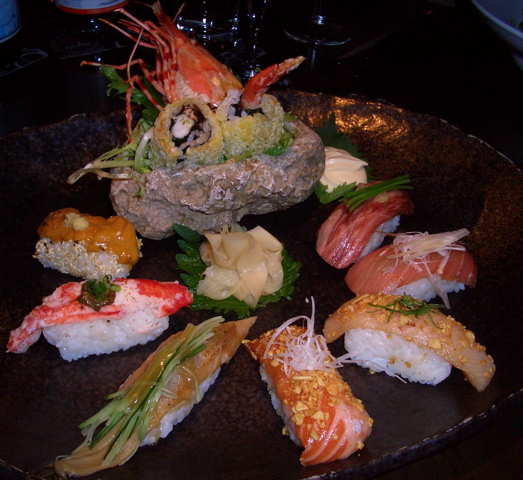 but I’m fairly sure that a single, large vertical
rigatoni
stuffed with duck confit in a light tomato sauce dusted with Parmesan
cheese
never appeared on a Doge’s table. The
sushi (right), however, was
impeccably presented, had the clearest and cleanest flavors,
and didn’t try too hard to impress the way the crazy pasta dishes did.
but I’m fairly sure that a single, large vertical
rigatoni
stuffed with duck confit in a light tomato sauce dusted with Parmesan
cheese
never appeared on a Doge’s table. The
sushi (right), however, was
impeccably presented, had the clearest and cleanest flavors,
and didn’t try too hard to impress the way the crazy pasta dishes did.But the real reason to book a table at this top floor restaurant is the view a table affords you for the nightly laser show that lights up
Aqua's steel and glass décor is über-trendy, bi-level, and cutting-edge,
Italian main courses at Aqua run from $32-40USD, and Japanese main courses are priced at $23-70USD.
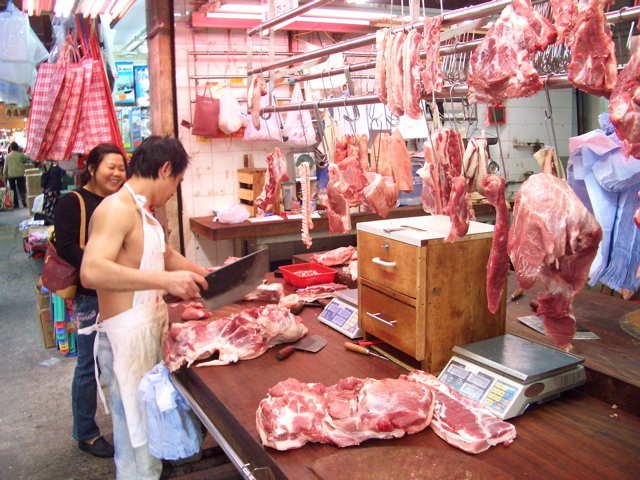 As I was
traveling with someone under the
impression there were things to do in
As I was
traveling with someone under the
impression there were things to do in
grayz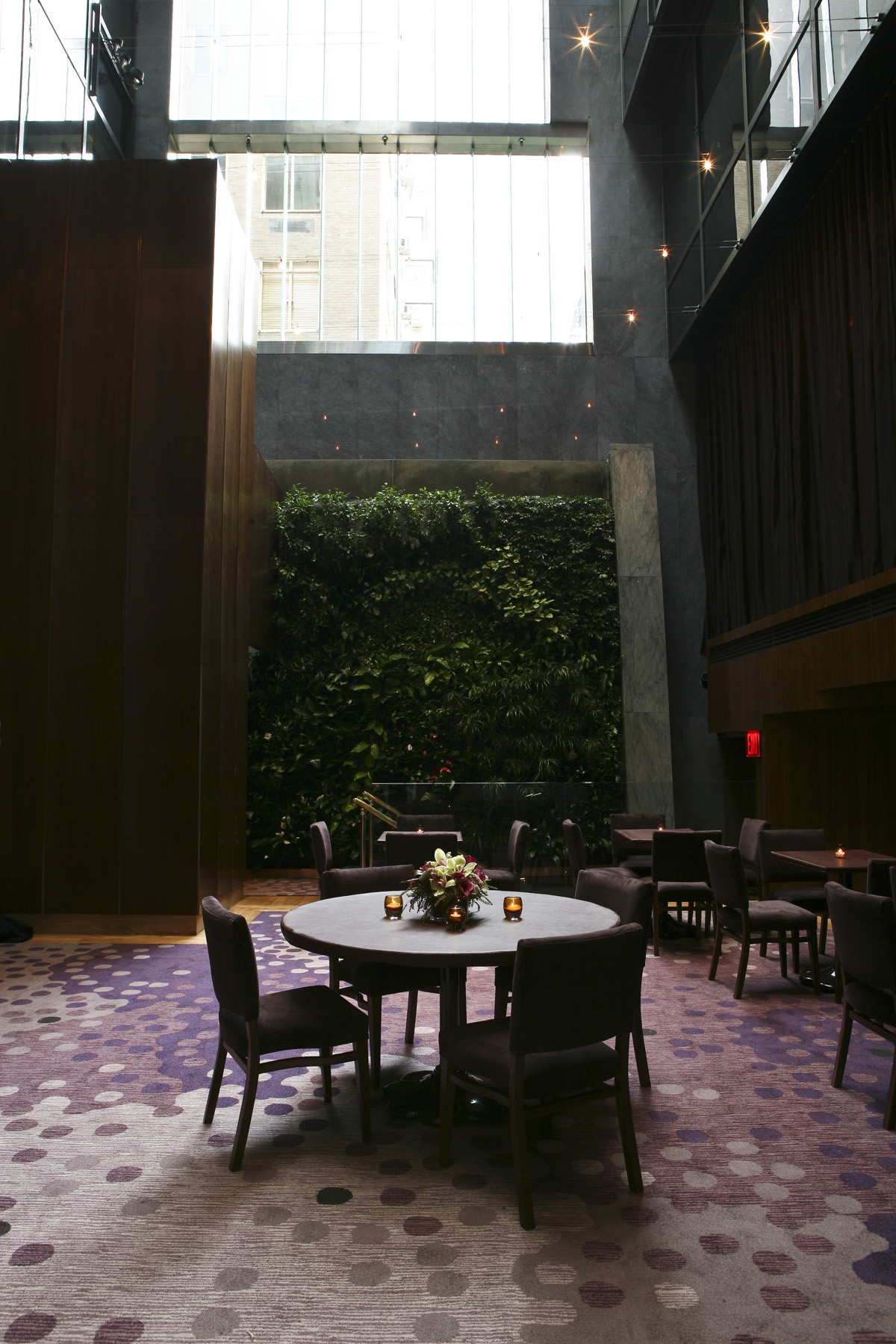
212-262-4600
www.grayz.net
One of the most striking features of Aquavit was a waterfall in the subterranean dining room (above) whose ceiling soars upwards for several stories. For reasons I can't begin to imagine, the waterfall is now kaput, and that splendid dining area is now reserved for private functions. Indeed, Grayz has been positioned as a function space, with visual and audio elements and a smaller private dining room upstairs at the level below the street where you enter. There in the main dining room they still have the old herringbone pattern antique wood floors, buttery leather seats and banquettes called "demi-lune sofas," and a sexy, well-lighted bar (below). It is all very sophisticated in a very New York way. Surprisingly the next floor down, whose only pleasing feature is a wine wall, is as dreary and drab as the upstairs room is cosmopolitan and colorful. Keeping the noise level down is easily accomplished by turning down the bass-and-boom of the canned music.
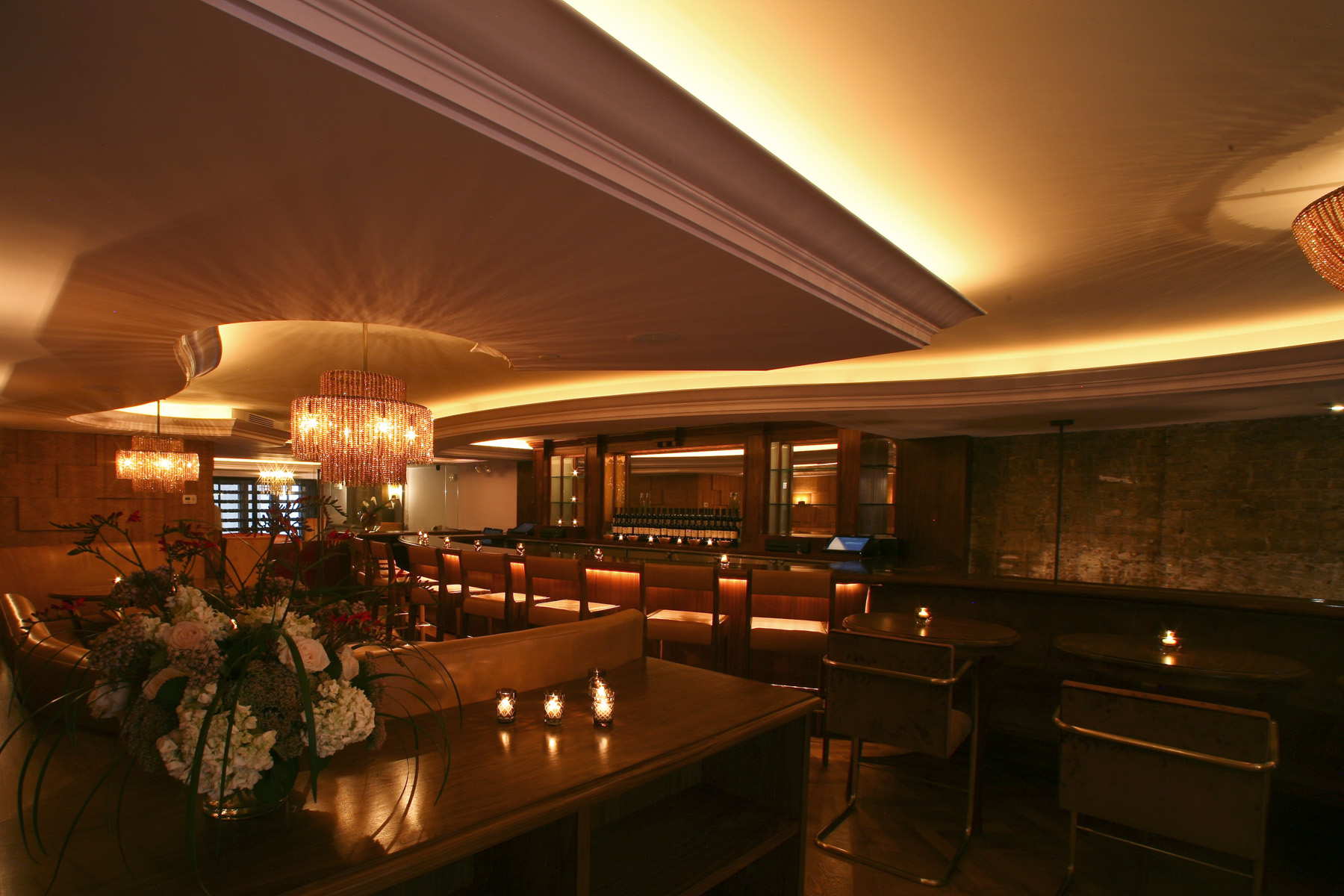 There is a pun in the name of the
restaurant, for the menu is mostly small plates, although main courses
at dinner can rise to $39. Grayz is one of those more casual but
not inexpensive restaurants for which Joël Robuchon's L'Atelier
concept gave the nod to important chefs that already include Ducasse
and Gordon Ramsay, on the assumption that people want wider
choice, smaller portions, and less formality in the dining room--all of
which is admirable. You can certainly just drop into Grayz and
order a little of this or a lot of that, though you'll have a tough
time sharing the plates with friends. The small dishes are
certainly ample and the prices are pretty fair for this degree of posh,
mostly $11-$18, with some a delicious foie gras terrine with truffles
in millefeuille pastry with
parsnip, chanterelles and a Port wine jus
at $22. There is also a 5-course tasting menu at $85 that is good
value, and the winelist has something for everyone's budget, along with
a slew of novel cocktails.
There is a pun in the name of the
restaurant, for the menu is mostly small plates, although main courses
at dinner can rise to $39. Grayz is one of those more casual but
not inexpensive restaurants for which Joël Robuchon's L'Atelier
concept gave the nod to important chefs that already include Ducasse
and Gordon Ramsay, on the assumption that people want wider
choice, smaller portions, and less formality in the dining room--all of
which is admirable. You can certainly just drop into Grayz and
order a little of this or a lot of that, though you'll have a tough
time sharing the plates with friends. The small dishes are
certainly ample and the prices are pretty fair for this degree of posh,
mostly $11-$18, with some a delicious foie gras terrine with truffles
in millefeuille pastry with
parsnip, chanterelles and a Port wine jus
at $22. There is also a 5-course tasting menu at $85 that is good
value, and the winelist has something for everyone's budget, along with
a slew of novel cocktails.The service staff, led by manager George Atterbury, is as finely tuned and attentive as any in New York. Just don't let them sit you in that room downstairs.
Among the "finger food and small plates" there were plenty of winners, including that truffled foie gras, and applewood smoked salmon with hickory salmon caviar and bourbon maple-syrup, which would make as good a late breakfast dish as I can imagine. Salt-stone grilled prawns were juicy and smoky, with a kaffir-scented rémoulade, and a hearty veal weisswurst with mustard came with just about the best pretzels you'll find in New York (don't get me started on those hard, cold, cardboard-like, salty horrors they sell on the street corners!).
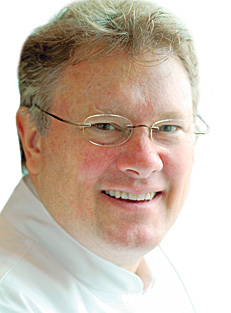
Larger plates include seared venison loin with red cabbage, chestnuts, and lingonberry-salmis sauce, a grilled branzino with a classic Champagne beurre blanc sauce dotted with caviar, and grilled red snapper in a court bouillon--each dish showing Kunz's classic precision to a T. The same goes for his crisp roasted duckling with pears, Brussels sprouts and a light cider reduction. And in a city swarming with braised short ribs, Kunz's were superlative, with creamed spinach and an assertive tarragon and horseradish emulsion. For dessert go with a soufflé--again classic--served with a blood orange salad.
I have not had lunch at Grayz, when the menu is lighter and quite a bit different, but I suspect everything here shows the underpinnings of a master chef.
Gray Kunz
Grayz is open for lunch Mon.-Fri., for dinner Mon.-Sat.
NOTES FROM THE WINE CELLAR
Duckhorn Still Sets the Mark for American Merlot
by John Mariani
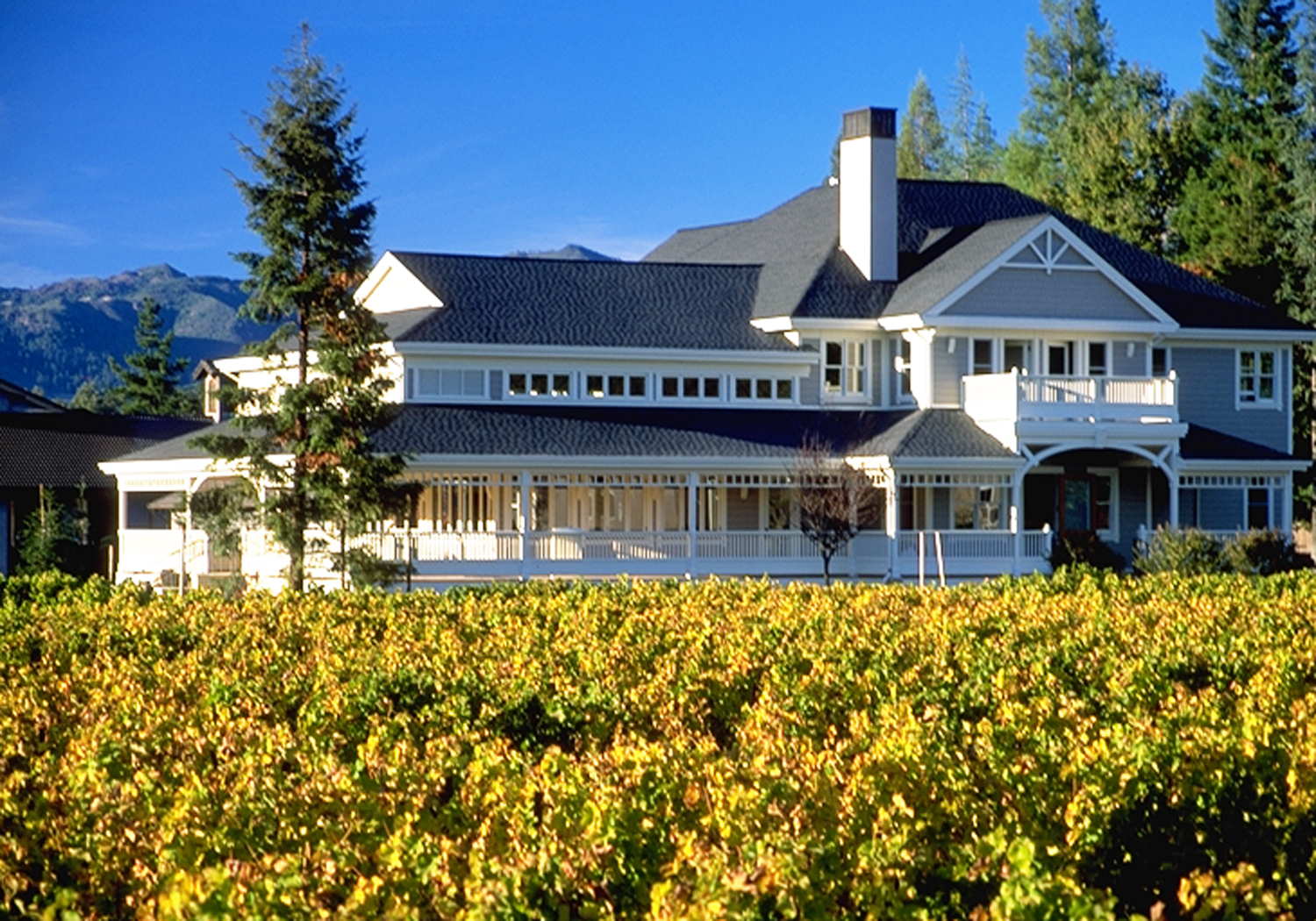
When I got an invitation back in 1980 to attend a wine media dinner to be held by
Back in the late 1970s few
I remember very clearly smelling and tasting the wine, with a definite but very pleasant herbal nose. What amazed me was the complexity and richness, the soft tannins, and the sheer brightness of a varietal I had mostly dismissed in the past.
As impressed as I was, at the time I had no way of knowing if any but Duckhorn’s merlots had a future. As it worked out, largely because of Duckhorn’s efforts, merlot soon became an enormous success story among California winemakers, Costing far less than cabernet sauvignon, the wine hit the right sweet spot for a burgeoning generation of Americans ready for something so easy to drink, adaptable to so many foods, and, by the 1980s, so readily available. And, as the “Oxford Companion to Wine” (third edition, 2006) notes, DNA research suggests that merlot “is likely to be the progeny of cabernet franc . . . and probably half-brother to cabernet sauvignon.”
Merlot plantings grew exponentially (it is the predominant red grape planted in
By the 1990s merlot was experiencing double digit sales growth, from 1.6 millions cases in 1995 to 7.8 million in 2005, and it is still the leading red varietal purchased by Americans today. But sales started to flatten out in 2004—not coincidentally the same year the hit movie “Sideways” came out, in which pinot noir snob Miles Raymond screams, “I’m not drinking any #%^** merlot!”
Merlot’s fall from grace after that movie came out had many winedrinkers switching to pinot noir, and I can’t say I blame them. Too many
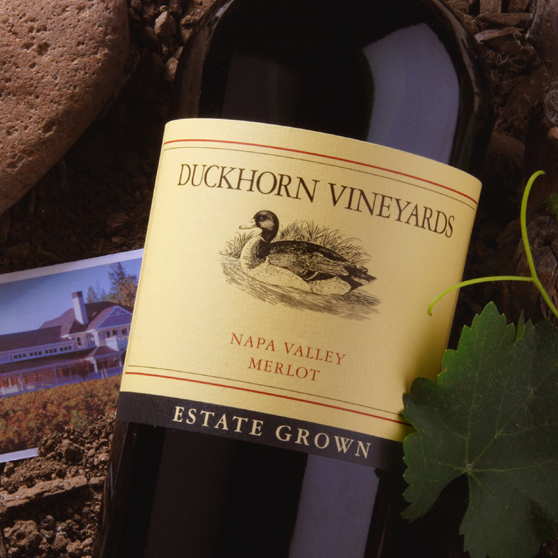
Then this past weekend at home I happened to open a bottle of Duckhorn’s 2004 Estate Grown Napa Valley Merlot ($85), which I drank, oddly enough, with filet of cod with slices of chorizo sausage and coco bean puree. I chose merlot because the sharp, spicy chorizo needed a soft red wine, and the cod needed something not too complex.
My first sip time-warped me right back to that dinner in 1980. The wine was luscious, its tannins solid but softening, its fruit tremendous, and its bouquet smelled of the soil it came from, along with sage and plum notes. Made from 95 percent merlot and 5 percent cabernet franc, aged for 20 months in new French oak, with 14.5 percent alcohol, it is a wine that can age but doesn’t need five to ten years like Pétrus.
With a loin of roast pork, I also tried Duckhorn’s 2005 entry level merlot ($52). While not as rich or complex, it was a good, solid, racy example of what made Duckhorn’s merlots so appealing in the first place. (Duckhorn also makes several single estate merlots, along with Paraduxx, a zinfandel-cabernet sauvignon blend, and Goldeneye, a pinot noir.)
Just to see what the competition was up to, I also tried a Bookster Napa Valley Merlot 2005 ($35), about which I knew nothing. It was massive, so tannic, even after two hours of decanting, that I thought I was drinking Indigo ink. Had it been the only merlot I tasted this year, I might well have given up on the varietal. But as long as Duckhorn still bears the standard, I will happily keep drinking the #*&*% merlot.
~~~~~~~~~~~~~~~~~~~~~~~~~~~~~~~~~~~
John Mariani's weekly wine column appears in Bloomberg Muse News, from which this story was adapted. Bloomberg News covers Culture from art, books, and theater to wine, travel, and food on a daily basis, and some of its articles play of the Saturday Bloomberg Radio and TV.
~~~~~~~~~~~~~~~~~~~~~~~~~~~~~~~~~~~~
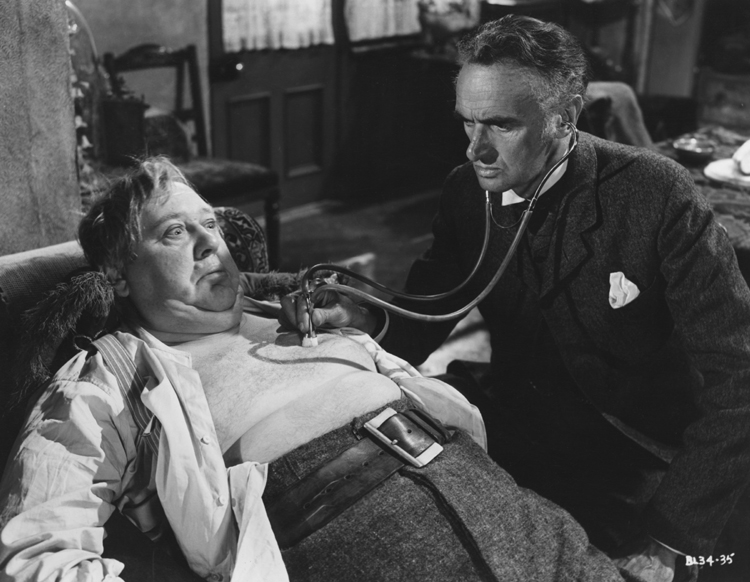 AFTER
THE SECOND DAY HE ASKED
FOR TWO OLIVES AND THE NURSE TO SING "MELANCHOLY BABY"
AFTER
THE SECOND DAY HE ASKED
FOR TWO OLIVES AND THE NURSE TO SING "MELANCHOLY BABY"A 24-year-old Italian tourist was given a drip-feed of 100-proof vodka at an Australian hospital after doctors ran out of medicinal alcohol to treat him after he swallowed an antifreeze ingredient, ethylene glycol, which can cause renal failure. The drip-feed of vodka equaled about three drinks an hour for the three days the man spent in intensive care. The patient made a successful recovery.
AND THEN THE BOUNCER ASKED US TO LEAVE

QUICK BYTES
* From Feb. 29-March 2 the Sixth Annual Boca Bacchanal Winefest & Auction presented by Boca Raton Magazine, Boca Raton Resort & Club and Republic National Distributing Company will hold a live auction to support educational causes , with 8 Vintner Dinners ($325 pp) at private residences on Fri. evening; a Sat. evening Bacchanal & Auction ($250) at the Boca Raton Resort & Club, and the Sunday Grand Tasting ($75), with a “revelry on the green” at the Centre for the Arts at Mizner Park Amphitheatre, with 30 local restaurants and more than 140 wines. Call 561-395-6766.
* From Feb. 29-March 3, the Southeast Regional Conference of the American Culinary Federation will meet at the Williamsburg Lodge, in
* On March 2 and 3, the James Beard Foundation will honor winemaker Christian Moueix of Dominus Estate and Château Pétrus at the 3rd Legends of Wine event in Napa Valley, hosted by chef/owner Ken Frank of La Toque in Rutherford, with
*
* The New York Wine Expo will be held March 7 & 8 at the Jacob Javits Convention Center, featuring more than 600 wines from more than 170 global winemakers. In addition to sampling, consumers can learn from the experts at a wide range of seminars designed for all levels of wine lovers. Topics include wine tasting, wine and food pairings, wine serving, selecting the right vintage, among others. Mark Oldman, one of the country's leading wine educators as well as the Wine Columnist for "Every Day With Rachael Ray" will be delivering the Keynote Address entitled "Outsmart Wine with Mark Oldman" on Saturday. Tickets can be purchased in advance online at www.NewYorkWineExpo.com and at the door on the day of the event.
Everett Potter's Travel Report:
Tennis Resorts Online: A Critical Guide to the World's Best Tennis Resorts and Tennis Camps, published by ROGER COX, who has spent more than two decades writing about tennis travel, including a 17-year stretch for Tennis magazine. He has also written for Arthur Frommer's Budget Travel, New York Magazine, Travel & Leisure, Esquire, Money, USTA Magazine, Men's Journal, and The Robb Report. He has authored two books-The World's Best Tennis Vacations (Stephen Greene Press/Viking Penguin, 1990) and The Best Places to Stay in the Rockies (Houghton Mifflin, 1992 & 1994), and the Melbourne (Australia) chapter to the Wall Street Journal Business Guide to Cities of the Pacific Rim (Fodor's Travel Guides, 1991). Click on the logo below to go to the site.
~~~~~~~~~~~~~~~~~~~~~~~~~~~~~~~~~~~~~~~~~~~~~~~~~~~~~~~~~~~~~~~~~~~~~~~~~
MARIANI'S VIRTUAL GOURMET NEWSLETTER is published weekly. Editor/Publisher: John Mariani.
Contributing Writers: Robert Mariani,
Naomi
Kooker, Suzanne Wright, John A. Curtas, Edward Brivio, Mort
Hochstein, Suzanne Wright. Contributing
Photographers: Galina Stepanoff-Dargery, Bobby Pirillo. Technical
Advisor: Gerry McLoughlin.
Any of John Mariani's books below
may be ordered from amazon.com by clicking on the cover image.
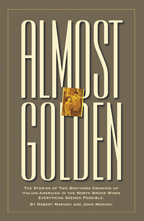 My
newest book, written with my brother Robert Mariani, is a memoir of our
years growing up in the My
newest book, written with my brother Robert Mariani, is a memoir of our
years growing up in the For those of you who don't think of the Robert and I think you'll enjoy this very personal look at our --John Mariani |
 |
 |
 |
 |
 |
 |
© copyright John Mariani 2008

